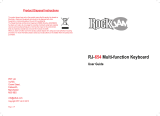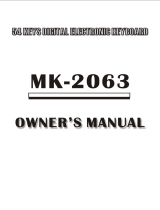
© Copyright Lotronic – 2017 MEK61128 Manual 17
Connectors op de achterkant:
Aansluiting op een versterker of een audiosysteem
Ondanks de aanwezigheid van een interne luidspreker, kan u ook opteren
om het toetsenbord aan te sluiten op een versterker of externe
luidsprekers. Schakel eerst alle betrokken toestellen uit. Sluit de
stereokabel aan op de L/R Uitgang op de achterzijde en op de LINE IN of
de AUX IN van de externe uitrusting.
Aansluiting van een hoofdtelefoon
U kunt een hoofdtelefoon aansluiten d.m.v. een stereo jack 6.35mm plug op de achterzijde van het toestel. Dit
onderbreekt automatisch de interne luidspreker waardoor u in alle stilte kan oefenen zonder overlast voor uw
omgeving.
Aansluiting van een microfoon
Sluit de meegeleverde microfoon (alléén model MEK61128-PACK) op de MIC ingang aan.
Gebruik van de stroomadapter
De gebruikte adapter moet voldoen aan de specifieke technische karakteristieken van dit instrument. Sluit de
adapter aan op de DC stroomconnectie in de achterzijde van het toestel en op de netstroom.
Opmerkingen:
A. Wees zeker dat het instrument op een laag volume ingesteld is alvorens u de aansluitingen maakt.
B. Verhoog het volume totdat het gewenste niveau bereikt is.
C. Zie de handleiding van de versterker voor de juiste aansluiting en instructies.
Plaatsen van de batterijen
Indien een netadapter op het toetsenbord aangesloten is worden de batterijen niet gebruikt.
Open het batterij vak op de onderzijde van het instrument en plaats zes 1,5Vdc ‘D’ batterijen met de juiste polariteit
in het vak. Sluit het vak.
Opmerking: Als de spanning van de batterijen te lag wordt en het instrument niet goed werkt, vervang de batterijen.
Verwijder de batterijen indien u het instrument voor een lagere periode niet gebruikt.
Nooit nieuwe en oude batterijen of verschillende types mengen. Buiten het bereik van kinderen houden. Nooit oude
batterijen in het huisvuil gooien.
LED DISPLAY
X= 1 digit; XX= 2 digits; XXX= 3 digits
AXX: Achtergrondvolume +/-
000
rhy
Prg
0o
d
rEC
OFF
Ply
Als u het toetsenboard aanschakelt toont de display de fabrieksinstelling 000 zijnde piano. De fabrieksinstelling van
het ritme is 000. Kies het ritme, de klankkleur of de song. De display toont het ingestelde ritme, klankkleur of song
nummer. Als een ritme of song afgespeeld wordt flitsen de punten op de display volgens het ritme van de slagen.
Schuif de POWER schakelaar (2) op de ON positive om het keyboard in te schakelen.
Druk de MASTER volume toetsen (3) om het volume op het gewenste niveau in te stellen.
Stel het achtergrondvolume RHYTHM (4) op het gewenste niveau tussen 1 en 16.
Stel het accoordvolume CHORD (5) op het gewenste niveau tussen 1 en 16.
Selectie van de klankkleur
Het instrument biedt 128 verschillende klankkleuren aan van “000” tot en met “127”. Eens het toestel in werking
wordt gezet, begint het automatisch met de klankkleurselectie en wordt “TONE” weergegeven. Indien dit niet het
geval is, kan u deze functie aanspreken door op de klankkleur toets te drukken (28).






















